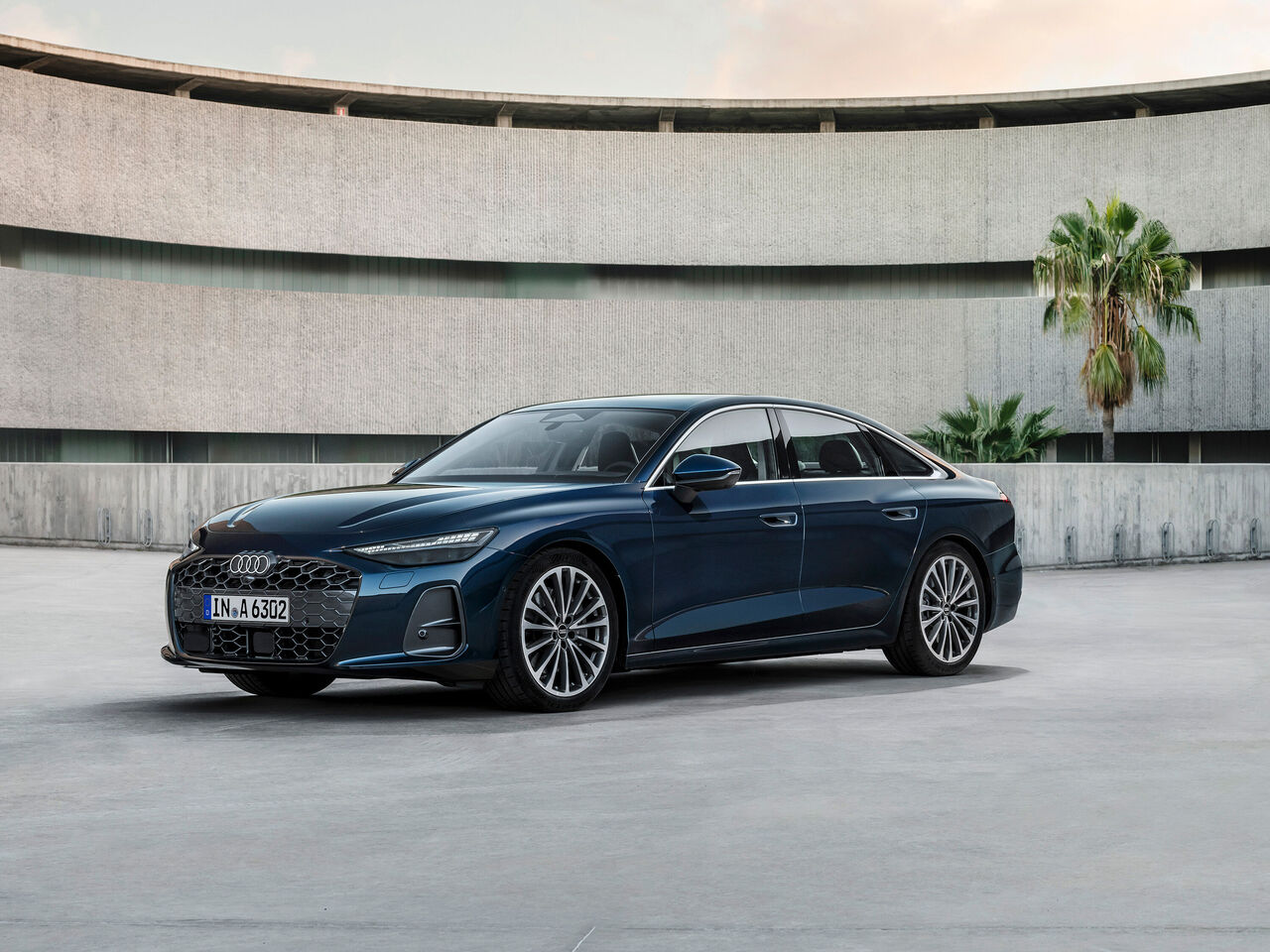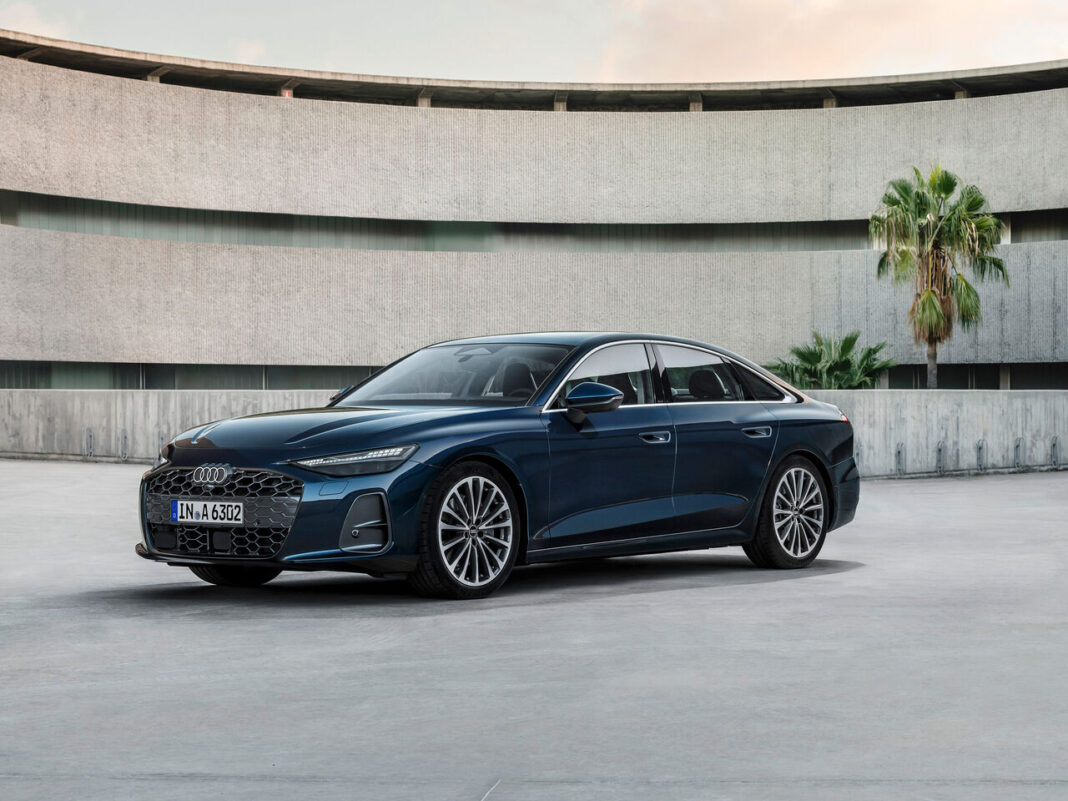
Fuel-efficient and high-performance: MHEV plus technology
At its launch, the new A6 Sedan will be available with three different engines – two gasoline and one diesel. Two of these three power units will feature mild hybrid technology (MHEV plus) and are therefore partially electrified.
The MHEV plus system supports the combustion-engine vehicle, enhances performance and ride quality, and reduces CO2 emissions. It consists of three main components: a 48-volt battery, a belt alternator starter, and the new powertrain generator with integrated power electronics. The lithium-ion battery, made of lithium iron phosphate, has a storage capacity of 1.7 kWh. The belt alternator starter’s primary function is to start the engine and supply the battery with electrical energy. The powertrain generator enables partially electric driving, provides additional torque, and feeds energy back into the battery during deceleration.
Partially electric driving: MHEV plus technology leverages the advantages of electric driving when parking and maneuvering. The electric driving components can also be used when driving slowly in the city, in slow-moving traffic, or outside city limits when coasting to the next village. In these situations, the A6 Sedan runs solely on the powertrain generator, making it particularly efficient.
A boost of up to 18 kW: MHEV plus technology supports the combustion-engine vehicle, for example when starting up in stop-and-go traffic or when passing. To do this, the powertrain generator produces additional torque up to 230 newton meters and up to 18 kW (24 PS) of power.
Regeneration of up to 25 kW: When decelerating, the powertrain generator recovers energy and feeds it – up to 25 kW of power – back into the battery (regeneration). The integrated, blending-capable brake control system ensures pressure-free braking and the best possible regeneration, in most cases without the use of the friction brake.
The 48-volt system also enables the use of an electrically driven air-conditioning compressor. The major advantage here is that even when the engine is switched off – for example when coasting or at a red light – the air-conditioning continues to operate at full power, keeping the interior at a comfortable temperature. Both the A6 Sedan TDI 150 kW and the A6 Sedan TFSI 270 kWquattro 270 kW: Combined fuel consumption in l/100 km: 7.8–6.7 (30.2–35.1 US mpg); combined CO₂ emissions in g/km: 177–153 (284.9–246.2 g/mi); CO₂ class: G–E” class=”inline-consumption-data”/> are equipped with the MHEV plus system.
2.0 TFSI 4-cylinder 150 kW: The entry-level variant with a 2-liter turbocharged gasoline engine, the A6 Sedan TFSI 150 kW, has a start-stop system as standard to reduce fuel consumption and is only available with front-wheel drive. It delivers 150 kW (204 PS) and generates a maximum torque of 340 newton meters. Numerous modifications have taken the efficiency of the newly designed engine to the next level. The 2.0 TFSI uses a modified Miller combustion process that is especially advantageous in partial-load operation. In the Miller cycle, the intake valves close early, which increases the engine’s efficiency. The 2.0 TFSI also has a turbocharger with variable turbine geometry (VTG). This improves the responsiveness and efficiency of the direct injection engine. The VTG enables smoother and more agile torque build-up at low engine speeds. The 2.0 TFSI is always coupled to the seven-speed S tronic, a fast and smooth-shifting dual-clutch transmission.
2.0 TDI 4-cylinder 150 kW: It delivers 150 kW (204 PS) and generates a maximum torque of 400 newton meters. To increase efficiency and comfort, the engine is partially electrified with MHEV plus technology and equipped with a 48-volt electrical system. Partially electric driving and high energy recovery reduce carbon emissions. The 48-volt belt alternator starter also increases the comfort of the TDI by starting the engine quietly. The vehicle responds more quickly when setting off and is noticeably more agile. The 2.0 TDI is available with a dual-clutch transmission as a front-wheel drive or quattro ultra all-wheel drive.
3.0 TFSI 6-cylinder 270 kW: The third option, the 3-liter V6 turbocharged engine, delivers 270 kW (367 PS)quattro 270 kW: Combined fuel consumption in l/100 km: 7.8–6.7 (30.2–35.1 US mpg); combined CO₂ emissions in g/km: 177–153 (284.9–246.2 g/mi); CO₂ class: G–E” class=”inline-consumption-data”/> and generates a maximum torque of 550 newton meters. It is the logical evolution of the engine that has been in series production since 2015 and has recently undergone a number of modifications: newly designed exhaust gas turbochargers with variable turbine geometry (VTG), indirect intercooling, optimizations in terms of charge exchange, the use of the Miller cycle, and modifications to the injection system. The engine produces high torque even at low speeds. In conjunction with the MHEV plus system, driving dynamics and comfort are noticeably improved and carbon emissions reduced. The V6 TFSI is always combined with quattro ultra all-wheel drive.
|
Technical data |
A6 Sedan |
A6 Sedan |
A6 Sedan |
|
Engine |
4-cylinder turbo gas engine with start/stop |
4-cylinder turbo diesel engine with MHEV plus |
6-cylinder turbo gas engine with MHEV plus |
|
Displacement in cm³ |
1,984 |
1,968 |
2,995 |
|
Drivetrain |
Front |
Front / quattro |
quattro |
|
Power output in kW (PS) |
150 (204) at |
150 (204) at |
270 (367) at |
|
Max. torque |
340 at |
400 at |
550 at |
|
Additional electric torque |
– |
18 (24) |
18 (24) |
|
Additional electric torque |
– |
230 Nm |
230 Nm |
|
Acceleration |
8.2 |
7.8 (6.9) |
4.7 |
|
Max. speed in km/h |
244 |
244 (243) |
250 |
|
Fuel consumption, combined, in l/100 km |
7.8-6.9 |
5.6-4.8 (5.8-5.0) |
7.7-6.7 |
|
CO2 emissions, combined, in g/km |
177-157 |
146-126 (152-131) |
174-153 |
Automobile Magazine

















